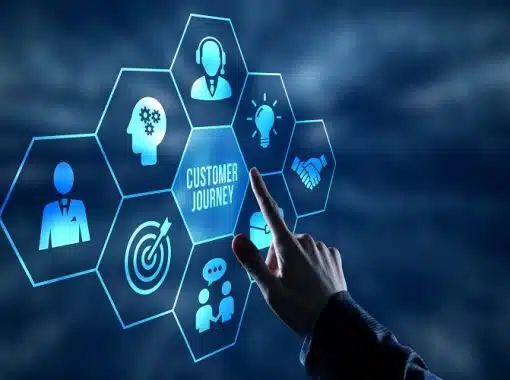
Building a customer journey map can help businesses gain insight into their customers’ buying habits and understand what motivates them to purchase a product or service.
By understanding the journey a customer takes, businesses can optimize marketing strategies and customer-facing processes, identify areas of improvement, and create an even better experience for the customer.
Table of Contents
What is a Customer Journey?
A customer journey is the series of steps a customer takes, from awareness to purchase, when engaging with a business. It begins when a customer first discovers the company and includes all their activities, interactions, and transactions leading up to a purchase.
By understanding the journey a customer takes, businesses can optimize and improve customer experience.
The customer journey is comprised of five main stages:
- Awareness: when your customer first discovers your business
- Research: when your customer starts researching products or services
- Evaluation: when your customer evaluates different options
- Purchase: when your customer makes the purchase decision
- Retention: when you ensure your customer is happy with the purchase
What is a Customer Journey Map?
A customer journey map is a visual representation of the path your customers take after they first interact with your business. A customer journey map visually outlines each step in the customer journey, from discovering your business to making a purchase.
The map provides businesses with an understanding of how customers interact with their product or service, what motivates them to purchase, and how they perceive their overall experience. This can help businesses make better decisions about how to optimize their customer-facing processes and marketing strategies.
Why Are Customer Journey Maps Important?
Customer journey maps give companies the insights they need to run their business better. Instead of only guessing what your customers need, your business will know and also know how to provide it for them.
Because a customer journey map allows you to visualize the many small decisions that customers make on their path, you can narrow your focus to just what they need and provide the right resources when they need them.
When a business has a customer journey map and understands the complete customer journey, it will know how to structure touchpoints that work for its customers. This means conversions happen quicker and fewer customers who need help will be neglected.
Steps to Creating a Customer Journey Map
Customer journey maps can definitely benefit your business, but how do you get started? Here are some general steps to building your own maps:
- Identify who your customer is: Who are your customers? What do they look like? What motivates them to purchase your product or service? What kind of experience do they have when engaging with your business? Understanding the demographic and psychographic traits of your customer is an important first step in creating a customer journey map.
- Map out your customer’s journey: Begin by mapping out the stages of the customer journey, from awareness to purchase, and note where and how customers interact with your business.
- Assess customer sentiment: Assess the sentiment at each stage of the customer journey. What emotions do they experience? Are they frustrated, confused, or satisfied?
- Identify areas of improvement: Look for areas of improvement in the customer journey. Are there any points where customers are likely to drop off? Are there any areas where the customer experience could be better?
- Test and refine: Test the customer journey map and look for areas of improvement. Make adjustments to the maps as necessary.
How to Build and Monitor Customer Journey Maps Easier
To build complete customer journey maps, you need tracking in place and data to analyze. It is the heart of every customer journey map. You also need to be sure you can follow the customer’s journey from one medium to another. With many phone systems, you don’t have the option. You know you got a call, but not where the call came from. Call tracking and call analytics will allow you to follow your customers on their journey from your website or your ads directly to your phone calls for a complete view of the path they took.












